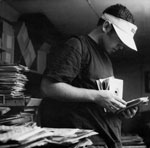
Honest Jons is one of those salvage operations in the tradition of Kent, Blood and Fire, and Soul Jazz, that pay great attention to detail, and produce a package that goes way beyond what you might stick on the hi-fi. If you take the second volume in the London Is The Place For Me series, Val Wilmer’s ‘60s photos capture a mood just right, and fit perfectly into the wonderfully attractive and gloriously impractical paperback format designed by Will Bankhead, and which he had previously used for the Watch How The People Dancing London dancehall set.
Will Bankhead has been central to making Honest Jons’ releases look just right. The glorious deep soul series featuring Candi Staton, Bettye Swann, and Willie Hightower, is packaged in a generic spartan style, while the English folk underground collection is suitably stark and grainy. In delightful contrast the Cedric Im Brookes Light of Saba set comes in an incredibly intricate packaging that reprises the artfully awkward style of many of the Mo’Wax releases Bankhead was involved with.
The Honest Jons record shop in Ladbroke Grove provided the finishing school for a young James Lavelle. He was one of those extremely gifted and ambitious people that could make things happen when most of us are still sitting around dreaming. His Mo’Wax label may have had pretty inauspicious beginnings, but over time it became one of the great record labels, and maybe only Rough Trade in its first incarnation can look back on such an astonishing array of diverse visionaries, acts of folly, indulgence and pure genius. And so many of the releases looked so right.

It’s a dangerous generalisation, but the core Mo’Wax sound is that of instrumental hip hop soundscapes, electronic beat collages, taking in everything from jazz to drum’n’bass via punk, funk, folk and vanity projects. At times it’s seemed as cool as Postcard and Basic Channel/Chain Reaction, and at other times it’s been as infuriating as Creation or Acid Jazz.
The intriguing thing is that culturally Mo’Wax caught something much broader than a series of exceptional records ordinarily can, if that’s not some sort of mixed-up oxymoron. Mo’Wax makes me think of skateboarders, graffiti artists, chancers, the international b-boy culture, cratediggers, headnodders, hip hop snobs with backpacks, limited edition t-shirts, and comics of course, and that montage Bankhead did for DJ Shadow. The Will Bankhead and Ben Drury design for DJ Shadow’s definitive Endtroducing … set captures this whole thing best of all.
For many DJ Shadow may be Mo’Wax, and certainly Endtroducing … and the records leading up to are magical montages, which are as painfully put together as say Pet Sounds or Don’t Stand Me Down, and as essential and emotional. And, yes, a very special snapshot of a moment in time would be the Shadow deep in concentration behind the counter of the Neal’s Yard Rough Trade shop, conjuring with slabs of vinyl, and creating a mad wall of noise, as people passed up records at random for him to mix in, and his smile of delight as someone proferred the latest Sonic Youth. Yet why were there only a few dozen of us there on a Saturday afternoon, grinning in delight, and nodding in homage to Dan the Automator standing there with us.

Yet Mo’Wax was so much more than DJ Shadow. Andrea Parker’s Kiss My Arp is one of the all time great records, while others like the Attica Blues and As One sets are lost classics. My own argument is that beyond the vanity projects Mo’Wax was at its most interesting the more messy things got later in the day. My own most played Mo’Wax records include the Divine Styler, Quannum, the Miami Bass and dancehall collections, the Parsley Sound set, and especially The Collapse of Modern Culture classic from Urban Tribe, which was deep techno at its very best, and indeed one of Will Bankhead’s best designs.
It may be unfair to focus too much on Bankhead, as I’m sure that looking at sleeve credits Ben Drury deserves more praise for his daring, and officially Bankhead went off to work on his own Park Walk clothing line. I kind of like this idea of designers, and exclusive t-shirts. It’s something almost totally at odds with the unearthing of nuggets-among-rubbish ethos of the cratediggers, but very much in keeping with the concept of one-upmanship. I’ve seen mentions of how Japanese financiers’ interference in that early clothing design excursion spoiled things, and you need not look any harder to find a metaphor for the music business and maybe Mo’Wax.
One of the early absurdist sleeve designs Will Bankhead and Ben Drury did was for Money Mark’s Keyboard Repair pop surrealism set. Money Mark was an alumni of the Beastie Boys, and there was considerable overlap between the Beasties’ and the Mo’Wax camps. In some ways the Beasties had provided a template for Mo’Wax activities with their Grand Royal label, magazine, and X-Large/X-Girl (the latter curated and created by Kim Gordon) clothing lines. One of the signings to the Grand Royal label were Luscious Jackson, whose New York pop drew on their city’s sounds like ESG, Liquid Liquid, Bush Tetras from the 99 stable and the wider UK connections like the On-U family, Maximum Joy, Viv Goldman, Slits. Mo’Wax would be among the first to follow up these leads, and impressively put together a beautifully packaged Liquid Liquid compilation when most people were looking in entirely the other direction.
Will Bankhead and Ben Drury would be working together again at a time when the UK underground music scene was undergoing something of a renaissance, and their names were associated with the street sounds of Dizzee Rascal and Wiley, among others. A cover shot by Bankhead of Wiley walking away with his back to the camera again captures something beyond the music.
© 2006 John Carney